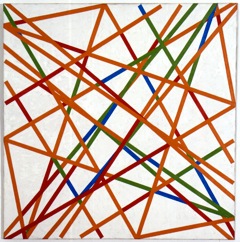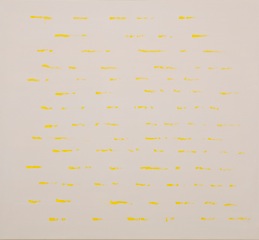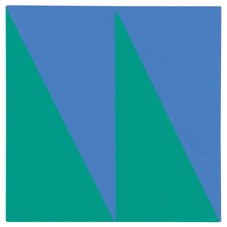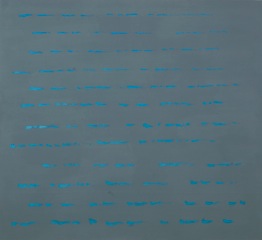Line & Circle and Edwina Leapman at Annely Juda Fine Art
Although to speak about silence is to risk obscuring the very experience one might wish to elucidate, to keep silent is to risk it going unappreciated. I feel similarly about the wonderful exhibition(s) currently on show at Annely Juda Fine Art. I will be careful not to say too much, but I must say something. I will keep quiet about the wonderful space on the fourth floor with a skylight that is perfect for viewing the new paintings by Edwina Leapman, and say nothing about the beauty of the works in the Line and Circle exhibition on floor three. It’s ages since I saw Naum Gabo‘s linear constructions and constructions in space, and I had forgotten just how captivating they are. Was it in the 70s that there was a big show of these somewhere and we spent ages peering at tiny constructions in glass cabinets and glass covered plinths? And whilst looking, really looking (the response that Gabo achieves so consistently, not just for me, everyone seems to be studying so intently) it is silence that accompanies us.
So, I shan’t say a thing about the amazing paintings here by Friedrich Vordemberge-Gildewart (an artist only recently brought to my attention by Terry Greene in a recent blog post), Composition N. 204, 1944/5, demanding silent contemplative viewing, like the Max Bill painting pura III, modest in size at just over a foot square, and containing almost no detail, the space divided in half down the centre and each half being divided diagonally from upper left to lower right resulting in four triangles, two in a colour approaching indigo and two in green, also resembling a zig-zag or ‘W/M ‘shape.
Impossible to determine which form is figure and which is ground, it shifts continually, from green figure against blue ground to blue figure with green ground, the colour relationship between them seeming somehow to be just right, as if there was such a thing as “correct”. Motion is arrested as I fix my attention on this object/image. It’s not just that the experience is a silent one, it’s more that the painting is the visual equivalence of silence: shifting, dependent on our perception of it, between presence and absence.
The other, much larger, Max Bill painting on show here, rotation around expanding white, a brightly coloured diagonally oriented canvas, equally interesting, seems a little ‘noisier’. Perhaps it’s all that visual excitation. Similarly with the marvelous painting by Kenneth Martin from his Chance, Order, Change series: although quietude continues to attend my viewing, it seems slightly ‘noisier’ somehow than pura III; It has a ‘buzz’ about it. Based on preliminary drawings, this series of paintings is highly programmatic and yet incorporates chance, which defines the position of the lines and their sequence. The points of intersection on a grid of squares are numbered and the numbers written on cards which are then picked at random. A line is made between each successive pair of numbers. I am unsure how the colours are determined but I think I am right in saying that where a line has been crossed by another its colour is changed.

Kenneth Martin, Chance Order Change 20, Symmetry B, 1981, oil on canvas, 91.4 x 91.4cm, image by courtesy Annely Juda Fine Art
It’s a lively painting, and I am enjoying seeing it here in this room along with others that share with Martin an affinity with the tradition of constructivism (some more some less so: Ben Nicholson, Antony Caro, Josef Albers, Laszlo Moholoy- Nagy, Naum Gabo, Kazimir Malevich and Olga Rozanova ). I am also aware that it belongs in a series and I would like to see more of the series to place it within it’s own more specific context. But most of all I am enjoying the dialogue that this painting seems to invite me into. Perhaps that’s why I say its a noisier painting than some of the others: here I am talking to it about the process followed for its own production.
On the fourth floor Edwina Leapman‘s paintings also encourage thoughts about the process of making them, and the series context is also present: 15 paintings all made in 2012, all of two colours with a ground on which is drawn a sequence of horizontal lines. I have the impression that on each line the brush is loaded with paint and the paint deposited along the line until the brush is empty and then re-loaded to recommence on the line below. It looks as if the position of the line has been determined beforehand but the way the painted line looks is determined only by the process of drawing the brush across the coloured canvas.
In some of the paintings the ground and the line colour contrasts in hue and sometimes they match, but they are generally closely matched in tone. Although I feel drawn into that conversation about process, and even more so having seen the Max Bill painting pura III and wanting to compare and contrast them, they do then bid me to become silent again as I view.

Edwina Leapman, Untitled, 2012, acrylic on canvas, 168 x 183 cm, image by courtesy Annely Juda Fine Art
They have amazing optical qualities, that must be ‘simply’ the result of the colour and close tonal relationships. That so much sensation can arise from so little intervention I find surprising, also that each painting has a distinct character of its own, vastly different from the others whilst in structure being entirely similar.
It’s true that appreciating these is something more for experience than for words, and also that their visual charge ( I want to say power but that suggests something much more brash and not ambiguous enough for these) is extremely difficult to put into words. So I will cease my speaking and continue to look on in silence.
Edwina Leapman New Paintings is showing until 28 March and Line and Circle until 23 March.


I’d love to see these in person- very beautiful color and play with form. thanks for the post!
melprest (@mel_prest)
March 21, 2013 at 5:02 pm
Thanks for commenting, Mel, yes it makes a difference seeing them in person doesn’t it, even though the photos are a good second best? The size difference between the Leapman paintings and most of the others in Line and Circle is an important differential that is not shown in the photos here. Whilst it can be imagined with the help of an installation shot, only standing directly in front of them gets that sensation back. It’s similar (but in the opposite direction) with the small Max Bill. It was a good exhibition. Kenneth Martin is an ‘important’ British artist but somewhat overlooked I think.
Andy Parkinson
March 26, 2013 at 7:48 am
Always been a fan of Max Bill’s work, but haven’t thought of him in a while, so thanks for the knock upside the intellect . . . While different, still another who’s work is small and intimate and is just stunningly amazing as Max Bill . . . Thomas Nozkowski, I think you might enjoy . . .
charles kurre
March 25, 2013 at 7:45 pm
Thanks for commenting Charles. Yes, the two Max Bill paintings here were wonderful. The big one, hung on the diagonal, was equally amazing but I wrote about the small one partly because it was so modest in size. I do like Nozkowski paintings, though I have never seen any in the flesh, only in reproductions and I hadn’t realised they were small. On the theme of small and intimate there is currently an exhibition showing in UK (in Bristol) entitled “Intimate Abstraction” that seems to be getting some attention. There’s a good review of it, by its curator, at http://abstractcritical.com/note/intimate-abstraction-at-the-searchers-contemporary-bristol/
Andy Parkinson
March 26, 2013 at 8:03 am
hey Andy, Thanks for the link. I thoroughly enjoyed reading, and thought it hit the proverbial nail on the head. I especially liked the quote from Shakespeare’s King Lear at the end of the piece, “to see feelingly” . . . yes indeed. Charles
charles kurre
March 26, 2013 at 12:26 pm